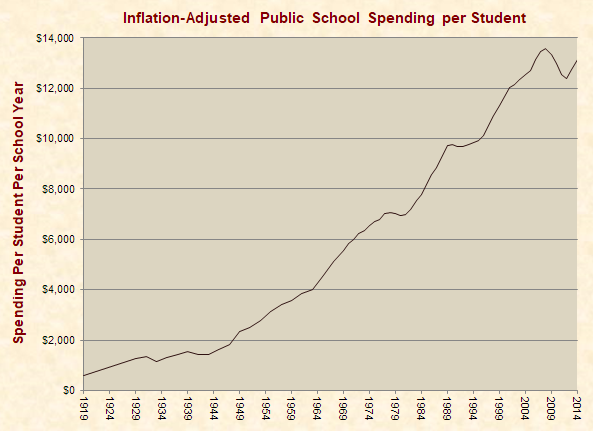The NEA’s massive money grab
Using Covid-19 as an excuse, the teachers union wants you to “invest” more in education; historical data put things into perspective, however.
Last week I reported on the American Federation of Teachers plea for more money to flow into government-run schools because of the Covid-19 crisis. Not to be outdone, the National Education Association has now weighed in, claiming that untold billions will be needed because “the nation stands to lose 1.89 million education jobs over the next three years, according to a new analysis.”
In its reopening guidelines, the union uses the word “invest” frequently because it insists the pandemic has “brought unprecedented challenges to our schools, our economy, and our nation’s families….” And their plan goes beyond just ensuring that teachers keep their jobs. For example, the union says that “policymakers must invest not only in education but also in addressing issues surrounding education: mortgage and rent cancellation for families in economic crisis; school-based community food programs; increased local hiring to provide jobs for unemployed adults….”
The point is that the unions have always claimed that we need to spend more on government-run schools. But now, with the advent of a pandemic, they are in overdrive.
Importantly, Rick Hess, director of education policy at the American Enterprise Institute, brings things back to earth in “The Schools That Cried ‘Wolf’,” a spot-on National Review piece. While Hess acknowledges the seriousness of the effects of Covid-19, he suggests that it’s difficult to take all the doom-and-gloom seriously. For example, he writes that long before the current crisis, United Teachers Los Angeles president Alex Caputo-Pearl “was urging his teachers to strike in order ‘to get the basics for students.’ Of course, Caputo-Pearl neglected to mention that the Los Angeles Unified School District was spending $18,788 per student, average teacher pay in Los Angeles was $78,962, and many of the district’s frustrations were due to UTLA’s unwillingness to adjust employee benefits, which had grown an astounding 138 percent between 2001 and 2016.”
Hess adds, “…the U.S. today boasts a teacher for every 15 students, and a school staff member for every eight — none of which suggests classrooms are ‘overcrowded’ (unless it’s because staff keep bumping into one another).” It was not always this way. The above photo shows my 3rd grade class picture in 1956 – before education became featherbedding central. Please note: 43 kids, a teacher and no aide. The school had a principal but no AP. We all learned.
Kennesaw State University economics professor Benjamin Scafidi finds that the number of teachers increased nationwide about 2.5 times faster than the uptick in students between 1950 and 2015. Even more egregious is the fact that the hiring of other education employees – administrators, teacher aides, counselors, social workers, etc. – rose more than 7 times the increase in students. Scafidi writes, “If the increase in ‘all other staff’ alone had matched student enrollment growth between FY 1992 and FY 2015—the most recent staffing data available—then a cautious estimate finds American public schools would have saved almost $35 billion in annual recurring savings. That is $35 billion every single year from 1992 to 2015, for a cumulative total of $805 billion over this time period.”
The following chart, courtesy of NCES and Just Facts, looks at 100 years’ worth of spending and dispels the union leaders’ and other “investocrats’” bunkum in a hurry.

As you can see from the inflation-adjusted figures, we have increased our education spending over 17-fold in the last century. Also, using data from the Digest of Education Statistics, the Cato Institute’s Andrew Coulson, found that we tripled our spending between 1970 and 2010 – and had absolutely no academic progress to show for it.
Sadly, too many people buy into the lies, in large part because major American newspapers support the union narrative. Hess notes, “As researchers Arthur Peng and Jim Guthrie observed a decade ago, ‘If one relies on newspaper headlines for education funding information, one might conclude that America’s schools suffer from a perpetual fiscal crisis, every year perched precariously on the brink of financial ruin, never knowing whether there will be sufficient funding to continue operating.’” As Mark Twain is alleged to have said, “A lie can travel halfway around the world while the truth is still putting on its shoes.”
Most recently, Corey DeAngelis and Matthew Nielsen revealed that The New York Times, Washington Post, and Philadelphia Inquirer have all made false funding assertions that would shame Pinocchio.
The classic film On the Waterfront portrayed union power at its rawest. In the 1950s, the unions typically got their way using nothing less than brute force. But today the tactics are different. In “Pretty Boy Floyd,” Woody Guthrie sang, “Some will rob you with a six-gun, and some with a fountain pen.” The unions are well entrenched in the “fountain pen” camp and the American taxpayer is in their crosshairs.
* * *
Larry Sand, a former classroom teacher, is the president of the non-profit California Teachers Empowerment Network – a non-partisan, non-political group dedicated to providing teachers and the general public with reliable and balanced information about professional affiliations and positions on educational issues. The views presented here are strictly his own.
